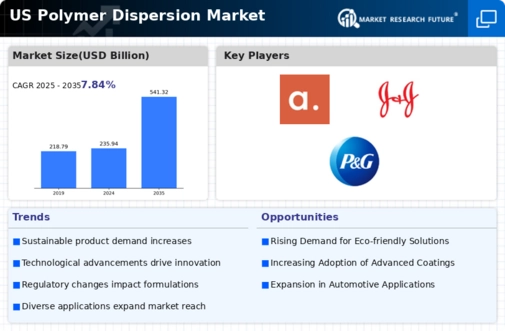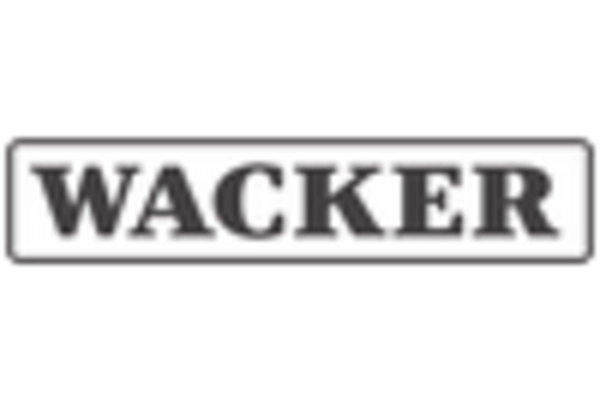The polymer dispersion market is characterized by a dynamic competitive landscape, driven by innovation, sustainability, and strategic partnerships. Key players such as BASF SE (DE), Dow Inc. (US), and 3M Company (US) are actively shaping the market through their distinct operational focuses. BASF SE (DE) emphasizes innovation in product development, particularly in eco-friendly formulations, which aligns with the growing demand for sustainable solutions. Dow Inc. (US) is pursuing regional expansion, enhancing its manufacturing capabilities to meet local market needs. Meanwhile, 3M Company (US) is leveraging digital transformation to optimize its supply chain and improve customer engagement, thereby enhancing its competitive positioning. Collectively, these strategies contribute to a moderately fragmented market structure, where innovation and sustainability are pivotal in differentiating offerings.
In terms of business tactics, companies are increasingly localizing manufacturing to reduce lead times and enhance supply chain resilience. This approach not only mitigates risks associated with global supply chain disruptions but also allows for more tailored products that meet regional specifications. The competitive structure remains moderately fragmented, with several players vying for market share, yet the influence of major companies is substantial, as they set trends and standards that smaller firms often follow.
In October 2025, BASF SE (DE) announced the launch of a new line of bio-based polymer dispersions aimed at the coatings industry. This strategic move underscores the company's commitment to sustainability and positions it favorably in a market increasingly focused on eco-friendly products. The introduction of these bio-based solutions is likely to attract environmentally conscious customers and enhance BASF's market share.
In September 2025, Dow Inc. (US) expanded its production facility in Texas, significantly increasing its capacity for polymer dispersions. This expansion is strategically important as it allows Dow to better serve the North American market, responding to rising demand for high-performance coatings and adhesives. The increased capacity is expected to bolster Dow's competitive edge by ensuring timely delivery and enhanced product availability.
In August 2025, 3M Company (US) launched an advanced digital platform designed to streamline customer interactions and improve order processing for its polymer dispersion products. This initiative reflects a broader trend towards digitalization in the industry, enabling 3M to enhance customer experience and operational efficiency. By integrating AI and data analytics, 3M is likely to gain insights that can drive product innovation and market responsiveness.
As of November 2025, the competitive trends in the polymer dispersion market are increasingly defined by digitalization, sustainability, and the integration of advanced technologies. Strategic alliances are becoming more prevalent, as companies seek to leverage complementary strengths to enhance their market positions. Looking ahead, competitive differentiation is expected to evolve, with a pronounced shift from price-based competition to a focus on innovation, technological advancements, and supply chain reliability. This transition may redefine how companies approach market entry and product development, emphasizing the importance of agility and responsiveness in a rapidly changing landscape.

















Leave a Comment